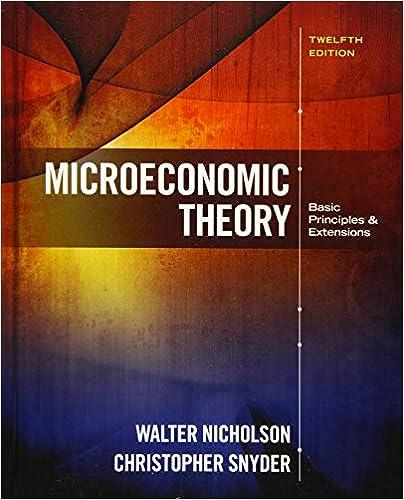This problem concerns the relationship between demand and marginal revenue curves for a few functional forms. a.
Question:
This problem concerns the relationship between demand and marginal revenue curves for a few functional forms.
a. Show that, for a linear demand curve, the marginal revenue curve bisects the distance between the vertical axis and the demand curve for any price.
b. Show that, for any linear demand curve, the vertical distance between the demand and marginal revenue curves is 21/b # q, where b 1,02 is the slope of the demand curve.
c. Show that, for a constant elasticity demand curve of the form q 5 aPb
, the vertical distance between the demand and marginal revenue curves is a constant ratio of the height of the demand curve, with this constant depending on the price elasticity of demand.
d. Show that, for any downward-sloping demand curve, the vertical distance between the demand and marginal revenue curves at any point can be found by using a linear approximation to the demand curve at that point and applying the procedure described in part (b).
e. Graph the results of parts (a)–
(d) of this problem.
11.8 How would you expect an increase in output price, P, to affect the demand for capital and labor inputs?
a. Explain graphically why, if neither input is inferior, it seems clear that a rise in P must not reduce the demand for either factor.
b. Show that the graphical presumption from part
(a) is demonstrated by the input demand functions that can be derived in the Cobb–Douglas case.
c. Use the profit function to show how the presence of inferior inputs would lead to ambiguity in the effect of P on input demand.
Analytical Problems 11.9 A CES profit function With a CES production function of the form q 5 1k ρ 1 l ρ2 γ/ρ
a whole lot of algebra is needed to compute the profit function as P1P, v, w2 5 KP1/112γ2 1v12σ 1 w12σ2 γ/112σ21γ212 , where σ 5 1/ 11 2 ρ2 and K is a constant.
a. If you are a glutton for punishment (or if your instructor is), prove that the profit function takes this form. Perhaps the easiest way to do so is to start from the CES cost function in Example 10.2.
b. Explain why this profit function provides a reasonable representation of a firm’s behavior only for 0 , γ , 1.
c. Explain the role of the elasticity of substitution 1σ2 in this profit function.
d. What is the supply function in this case? How does σ
determine the extent to which that function shifts when input prices change?
e. Derive the input demand functions in this case. How are these functions affected by the size of σ?
Step by Step Answer:

Microeconomic Theory Basic Principles And Extensions
ISBN: 9781305505797
12th Edition
Authors: Walter Nicholson, Christopher M. Snyder






